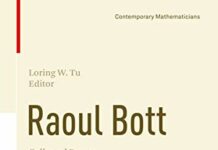
Ebook Info
- Published: 2017
- Number of pages: 364 pages
- Format: PDF
- File Size: 16.58 MB
- Authors: Loring W. Tu
Description
This text presents a graduate-level introduction to differential geometry for mathematics and physics students. The exposition follows the historical development of the concepts of connection and curvature with the goal of explaining the Chern–Weil theory of characteristic classes on a principal bundle. Along the way we encounter some of the high points in the history of differential geometry, for example, Gauss’ Theorema Egregium and the Gauss–Bonnet theorem. Exercises throughout the book test the reader’s understanding of the material and sometimes illustrate extensions of the theory. Initially, the prerequisites for the reader include a passing familiarity with manifolds. After the first chapter, it becomes necessary to understand and manipulate differential forms. A knowledge of de Rham cohomology is required for the last third of the text.Prerequisite material is contained in author’s text An Introduction to Manifolds, and can be learned in one semester. For the benefit of the reader and to establish common notations, Appendix A recalls the basics of manifold theory. Additionally, in an attempt to make the exposition more self-contained, sections on algebraic constructions such as the tensor product and the exterior power are included.Differential geometry, as its name implies, is the study of geometry using differential calculus. It dates back to Newton and Leibniz in the seventeenth century, but it was not until the nineteenth century, with the work of Gauss on surfaces and Riemann on the curvature tensor, that differential geometry flourished and its modern foundation was laid. Over the past one hundred years, differential geometry has proven indispensable to an understanding of the physical world, in Einstein’s general theory of relativity, in the theory of gravitation, in gauge theory, and now in string theory. Differential geometry is also useful in topology, several complex variables, algebraic geometry, complex manifolds, and dynamical systems, among other fields. The field has even found applications to group theory as in Gromov’s work and to probability theory as in Diaconis’s work. It is not too far-fetched to argue that differential geometry should be in every mathematician’s arsenal.
User’s Reviews
Reviews from Amazon users which were colected at the time this book was published on the website:
⭐The author has a special talent to be remarkably clear, uncommonly concise, and, at the same time, really precise!Te book’s quality is also like in the old days; one that is meant to last even if used heavily. Not like most of what is printed in these days (print on demand concept).To read this book you would probably need as background what is contained in the author’s book “An Introduction to Manifolds” which is also a great book!
⭐This is a masterpiece by Loring W. Tu.It treats the same material in Kobayashi and Nomizu’s famous “Foundations of Differential Geometry,” but does so in a much accessible and clear manner. This is a must-read by anyone who is interested in pursuing applying differential geometry!
⭐This book and Tu’s “An Introduction to Manifolds” compete with Jack Lee’s trilogy as the standard modern textbook introductions to manifolds and differential geometry. Tu’s books provide a clear, easy to follow and comprehensive path through the central topics in differential geometry that are important to both pure mathematicians and physicists alike. I view choosing between Tu’s or Lee’s books as matters of taste and choice of topics, not quality.
⭐Clear and concise. The historical chapters (first 8 chapters) are most useful in motivating he subject.
⭐Lucid text on differential geometry, but not for beginners.
⭐great book on advanced topics in differential geometry. Would recommend this book to any interested in general relativity
⭐This is a followup to Tu’s masterpiece, “Introduction to Manifolds” which covers the theory of smooth manifolds. This book covers standard topics from Riemannian Geometry including Riemannian metrics, connections, and curvature.Tu’s exposition like in his other book is characterized by its extreme clarity, precision, and concision. His notation is wonderful and the clearest that I have found in texts on differential geometry.What’s notable about this book as others have mentioned is that this book covers some topics typically found only in more advanced texts in a beginner friendly way specifically principal bundles and Ehresman connections.One downside of the book is that it is so concise that one can lose the geometry if one isn’t careful. Tu does a great job in the first few chapters of motivating the material in 3-dimensional space, but after that the discussion of the geometric aspects of the equations felt light to me. I’d contrast this with Lee’s Introduction to Riemannian Manifolds which has much more motivating discussion. The advantages of Tu’s book, though, is that if you don’t lose the plot you can get through it much quicker and it covers some advanced concepts not found in other introductions.The other complaint I have is that the binding wasn’t great in my book. The first chapter fell out.Overall, I’d rate it on par with Lee’s Introduction to Riemannian Geometry and recommend it for those have a need to learn things like principal bundles which aren’t covered in Lee’s book.
⭐I am a hobby mathematician only, so you should consider my comments with this in mind.The book covers what the title says.It is highly helpful for the understanding to have the knowledge of what is covered in the author‘s book ‚An Introduction to Manifolds‘!In an appendix the author covers the essentials of manifolds, unfortunately, there is no appendix for ‚de Rham Cohomology‘.In my view the book would be better if there was such an appendix.Without a good knowledge of de Rham, the last third of the book becomes difficult / incomprehensible, at least for me it was so- but the author tives this warning in his preface!There are very few typos, which is helpful for self study.With an appendix about de Rham cohomology, I believe 5 stars would be in order.
⭐Loring Tu’s book on Differential Geometry is simply a MASTERPIECE. I get the impression that ample thought has gone into writing every sentence, resulting in the most concise, efficient, but nevertheless sufficiently complete (for an introductory text), exposition on differential geometry that I have ever seen. Tu’s mastery of the subject is clear in every page. It will appeal to mathematicians, while being also fully accessible to physicists, it is thoroughly modern and even the examples and exercises have (seemingly) been cherry-picked, one by one, such that the concepts and tools are absorbed by the reader as fully and deeply as seemingly possible with such a text. This book is so captivating and clear that I can’t put it down. It will, I am sure, not be surpassed for a long time, and will surely become an instant classic.It starts off with a well-motivated discussion of curvature and vector fields (including Riemannian manifolds, connections, vector bundles, etc.), going on to differential forms, geodesics, Gauss-Bonnet thm, characteristic classes (including Pontrjagin, Euler, Chern), applications, and culminating in a beautiful detailed exposition of principle bundles (connections, curvature, covariant derivatives, etc.). There are also two carefully constructed appendices on the bare essentials of manifolds and invariant polynomials, nicely summarising some central concepts discussed in his `Introduction to Manifolds’ book. There are even colourful pictures/figures, including images of key milestone mathematicians that have helped shape differential geometry. Finally, `Differential Geometry’ by Tu lays down everything one needs to go on to study Bott and Tu’s classic, and (should this be desirable) to apply what they have learnt to their own research. (Incidentally, one reviewer dropped a star because there’s no section/appendix on de Rham cohomology; this is absolutely no limitation as the essentials of de Rham cohomology are covered with clarity in Bott and Tu and with even greater clarity in Tu’s ‘Introduction to Manifolds’.)
⭐There are already many books covering these topics, but this is certainly one of the nicest I’ve read. I went into it knowing most of the material moderately well from other places, but found the discussion here particularly clear and well motivated. This would be an excellent second book on differential geometry (it assumed you know about manifolds, and a bit about de Rahm cohomology), and sets the reader up well for more advanced material.
⭐excellent
⭐El libro es una obra maestra. Es la continuación natural de los otros libros de Lee. Recomiendo leer antes el libro An introduction to manifolds del mismo autor para tener una comprensión más fluida y total de este libro. No lo recomiendo para un primer acercamiento a la geometría diferencial. Lo considero más un libro para graduados de la carrera de matemáticas que quieren profundizar en los temas de geometría diferencial y Riemanniana.This book is the continuation to An introduction to Manifolds and it covers most of basic topics of Riemannian Geometry, but the last part focuses in Characteristic classes. It’s a another way to learn Riemannian Geometry instead using Lee’s or Do Carmos’ book
⭐
Keywords
Free Download Differential Geometry: Connections, Curvature, and Characteristic Classes (Graduate Texts in Mathematics Book 275) in PDF format
Differential Geometry: Connections, Curvature, and Characteristic Classes (Graduate Texts in Mathematics Book 275) PDF Free Download
Download Differential Geometry: Connections, Curvature, and Characteristic Classes (Graduate Texts in Mathematics Book 275) 2017 PDF Free
Differential Geometry: Connections, Curvature, and Characteristic Classes (Graduate Texts in Mathematics Book 275) 2017 PDF Free Download
Download Differential Geometry: Connections, Curvature, and Characteristic Classes (Graduate Texts in Mathematics Book 275) PDF
Free Download Ebook Differential Geometry: Connections, Curvature, and Characteristic Classes (Graduate Texts in Mathematics Book 275)

